The Very Bright Show that was Display Week 2024
Angie Kellen, Director, Client Services, Open Sky Communications
Recently, I had the pleasure of attending The Society for Information Display’s (SID’s) Display Week 2024 symposium and exhibition. If you are not familiar, the event covers the ecosystem around display innovations, from industry standards to manufacturing to technology advancements that include active-matrix devices, organic light-emitting diodes (OLEDs), and liquid-crystal display (LCD) technology.
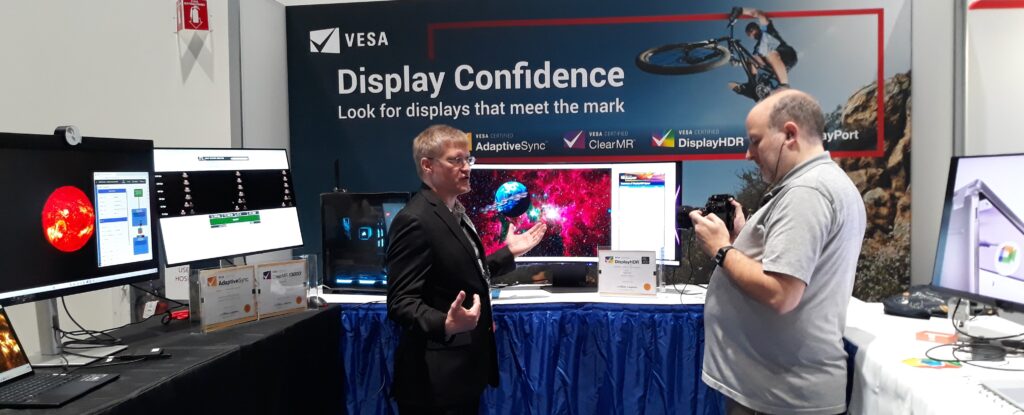
The stars lined up for me to attend as it was held at the San Jose McEnery Convention Center and I was supporting one of our clients, The Video Electronics Standards Association (VESA®), at the event. It had been a number of years since I was actually on the exhibit floor strolling through the booths. And since I am a naturally curious and visual person, I was looking forward to learning and seeing the new technologies that will eventually be available to consumers in the next couple of years. While there was a lot to look at and interesting behind-the-scenes technologies, this blog will focus more on the consumer display products.
From my perspective, it seemed like every booth had an OLED display in every imaginable size that featured a huge increase in brightness and resolution, which literally made the whole exhibition floor extremely bright. Of course I am exaggerating a bit, but not much. The buzz also included microLED, quantum dot, and flexible displays. These technologies were included in many applications such as TVs, PCs, tablets, phones and automotive dashboards. In addition, there were AR/VR glasses along with materials such as glass cleverly featured in the booths. I will touch on some of this in the next blog. Let’s start with what the big display guys brought to the show.
At Display Week, LG promoted its latest innovation called OLEDoS for VR. It is this technology that enticed me to visit the booth. Being shown to the public for the first time at Display Week, this display is the size of a coin, 1.3-inches and has a dramatically increased screen brightness and resolution over existing displays. In fact, it achieves an ultra-high brightness of 10,000 nits and an ultra-high resolution of around 4,000 ppi, which is in the 4K class.
To the right is the photo that was included in LG’s press release announcing the 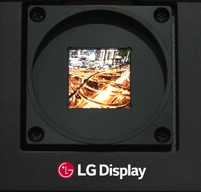 technology. Of course, this photo does not do justice to how bright and clear this display is in person. It was very popular and drew quite a crowd at the booth. Once I was able to see it up close, my pupils turned into pin-heads in three seconds! It was really bright, but once my eyes adjusted, it was very clear and quite impressive. I will be very interested to see which applications adopt this display in the near future.
technology. Of course, this photo does not do justice to how bright and clear this display is in person. It was very popular and drew quite a crowd at the booth. Once I was able to see it up close, my pupils turned into pin-heads in three seconds! It was really bright, but once my eyes adjusted, it was very clear and quite impressive. I will be very interested to see which applications adopt this display in the near future.
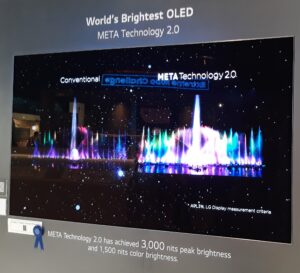 With my newly adjusted pupils, I was set up to check out the other LG OLED displays with enhanced brightness. Next was the ‘World’s Brightest OLED’ Display. LG did a great job of showing the side-by-side comparison of a conventional OLED display and the very bright LG OLED display using its META Technology. Although not as impactful as in person, it is so dramatic that you can even see the difference in the photo using my low-tech phone camera.
With my newly adjusted pupils, I was set up to check out the other LG OLED displays with enhanced brightness. Next was the ‘World’s Brightest OLED’ Display. LG did a great job of showing the side-by-side comparison of a conventional OLED display and the very bright LG OLED display using its META Technology. Although not as impactful as in person, it is so dramatic that you can even see the difference in the photo using my low-tech phone camera.
OLED displays tend to be dimmer than LED displays, and much dimmer vs LCD displays. A key reason is the fact that they lack a backlight and thus need to drive more electric current through the diode to increase the brightness, which can cause issues like burn-in. Well, they figured out the technology for efficient power delivery/usage and can now make these amazing increases in brightness and resolution for OLED displays. But do we really need them to be this bright? Are roasted retinas a thing?
According to LG, its OLEDoS may prove to be a way to deliver AR and VR in high definition even on the micro scale. VR displays require higher screen brightness and resolution than general displays to increase the viewer’s sense of immersion when external light is blocked.
OK, so if you are using AR/VR displays you ‘DO’ need the enhanced screen brightness. Got it.
There were many more displays in the large LG booth, but it was time for me to literally move on across the aisle to Samsung Display.
Immediately, you are drawn in by two curious sections of the booth. Once you approach, you find out that you are being entertained while learning of the amazing features of Samsung displays. I thought this was very well done, amusing and informative. As a result, Samsung had a steady stream of people in their booth drawn in by this tactic.
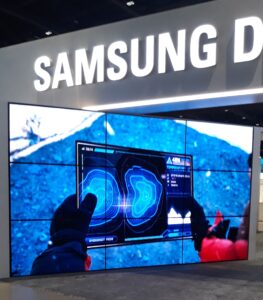 The first section has nine large OLED displays that made up an entire wall. Samsung was playing a video on a loop and I found it to be really clever and interesting how they wove in the features of their many displays into the video. It was like you were on a Disneyland ride where a video sets the stage for your upcoming adventure before you embark on the ride. The video starts up on Mount Everest, “Base camp we have a situation, we need to move out now for an emergency rescue.” As the video plays, you will see the many devices and applications used to perform the rescue. Samsung has incorporated OLED displays for harsh-weather device applications that include both rigid and flexible displays. The ski goggles are my favorite use of OLED displays in the video! Watching the video on the large OLED screens was pretty amazing too. Click here if you want to see the actual video that was shown in the booth.
The first section has nine large OLED displays that made up an entire wall. Samsung was playing a video on a loop and I found it to be really clever and interesting how they wove in the features of their many displays into the video. It was like you were on a Disneyland ride where a video sets the stage for your upcoming adventure before you embark on the ride. The video starts up on Mount Everest, “Base camp we have a situation, we need to move out now for an emergency rescue.” As the video plays, you will see the many devices and applications used to perform the rescue. Samsung has incorporated OLED displays for harsh-weather device applications that include both rigid and flexible displays. The ski goggles are my favorite use of OLED displays in the video! Watching the video on the large OLED screens was pretty amazing too. Click here if you want to see the actual video that was shown in the booth.
The second section of the booth that garnered a lot of attention was the “Extreme Robo Challenge.” So many people were around to watch this that I felt lucky to get a clear photo of the set up. This played every 15 minutes. The robot cleverly performed various tests on Samsung displays, such as a waterproof test of a cell phone by dunking it in water, a scratch test, impact test and more. All done by a robot with a personality in a chef’s hat. Samsung used this little guy at MWC2024 and someone captured it on video. If you want to see it, click here.

Flexible Displays
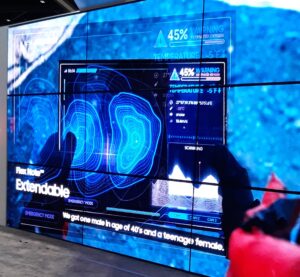 Most of the big display companies showed examples of flexible displays for tablets and phones. To the left is a closer look from the previous image above of Samsung Display’s Flex Note™ extendable tablet. You can see this in action in the video (timestamp 0:38-0:45), but it is basically a tablet that can be expanded in size because it uses a flexible OLED display, which means it has great clarity too. In the booth, it was worth waiting for the video to loop back to this section to watch it in action again. There were many of us asking when we could buy one!
Most of the big display companies showed examples of flexible displays for tablets and phones. To the left is a closer look from the previous image above of Samsung Display’s Flex Note™ extendable tablet. You can see this in action in the video (timestamp 0:38-0:45), but it is basically a tablet that can be expanded in size because it uses a flexible OLED display, which means it has great clarity too. In the booth, it was worth waiting for the video to loop back to this section to watch it in action again. There were many of us asking when we could buy one!
I felt that BOE showed the most compelling use of 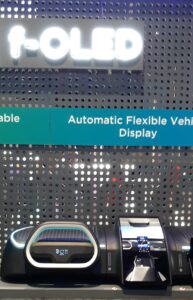 a flexible OLED display with its f-OLED display for automotive dashboards. There were many people in the booth that were excited at the clarity of the monitor as well as its use on a dashboard. Immediately, you can see its aesthetic value and with a low profile on the dashboard it can maximize visibility of the road over the current rigid displays in use today.
a flexible OLED display with its f-OLED display for automotive dashboards. There were many people in the booth that were excited at the clarity of the monitor as well as its use on a dashboard. Immediately, you can see its aesthetic value and with a low profile on the dashboard it can maximize visibility of the road over the current rigid displays in use today.
Transparent Displays
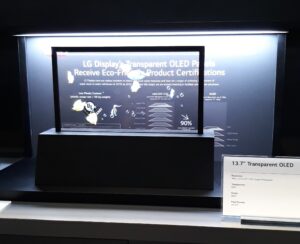 Also found in several booths were transparent displays. To the left is LG’s 13.7” transparent OLED display, which looked like a fish tank with colorful fish swimming around and through it you could read about the features of the display. Again, my photo did not capture the great colors of the fish in the display but rest assured this was a neat visual.
Also found in several booths were transparent displays. To the left is LG’s 13.7” transparent OLED display, which looked like a fish tank with colorful fish swimming around and through it you could read about the features of the display. Again, my photo did not capture the great colors of the fish in the display but rest assured this was a neat visual.
AUO showcased its 60” transparent Mirco LED display in its booth. They did a 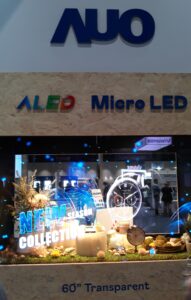 great job of illustrating the display’s advantages for retail applications. The images were bright on the display panel but also allowed you to easily view the items behind it. I look forward to seeing which retailers adopt this technology first.
great job of illustrating the display’s advantages for retail applications. The images were bright on the display panel but also allowed you to easily view the items behind it. I look forward to seeing which retailers adopt this technology first.
3D Displays
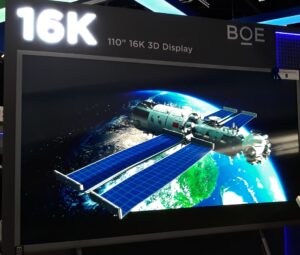 The last time I paid attention to this market, it seemed that 3D TVs and displays dropped out of our vocabulary and the powers that be were still trying to perfect the glasses. Not long ago, while we were upgrading to HD TVs, we were encouraged to upgrade to 3D TVs because all broadcast outlets were going to quickly move to 3D. We know that didn’t happen. However, BOE is working hard to revitalize 3D displays. They showcased a 110’, 16K, 3D display that does not require glasses. First, you are struck by the sheer size of the display and then the 3D effect. Now, full disclosure, you do have to get front and center to get the best viewing angle. If not, on the edges you’ll see a ripple effect as if you are underwater, which distracts from the great visuals that look like they are popping out of the display. So clearly some more work needs to be done, but it was really great to see this advancement in 3D displays.
The last time I paid attention to this market, it seemed that 3D TVs and displays dropped out of our vocabulary and the powers that be were still trying to perfect the glasses. Not long ago, while we were upgrading to HD TVs, we were encouraged to upgrade to 3D TVs because all broadcast outlets were going to quickly move to 3D. We know that didn’t happen. However, BOE is working hard to revitalize 3D displays. They showcased a 110’, 16K, 3D display that does not require glasses. First, you are struck by the sheer size of the display and then the 3D effect. Now, full disclosure, you do have to get front and center to get the best viewing angle. If not, on the edges you’ll see a ripple effect as if you are underwater, which distracts from the great visuals that look like they are popping out of the display. So clearly some more work needs to be done, but it was really great to see this advancement in 3D displays.
Display Week is an industry show that is very technical, and that is what makes it the best place to get a glimpse into the future of displays before they hit the market. My takeaway from the event is that the future of displays is bright…I mean very BRIGHT now that the OLED display technologies are producing cornea-crisping brightness and new levels of resolution. OLED displays can make many applications more immersive and as a result, I think we will see a great wave of adoption in the near future. I look forward to seeing the first adopters of this technology and for what applications. But, Display Week always has so much to see beyond the displays. In fact, I will be covering more of the show in my next blog and will include AR/VR components as well as the new materials enabling these amazing display advancements. Stay tuned for more on Display Week 2024.
makes it the best place to get a glimpse into the future of displays before they hit the market. My takeaway from the event is that the future of displays is bright…I mean very BRIGHT now that the OLED display technologies are producing cornea-crisping brightness and new levels of resolution. OLED displays can make many applications more immersive and as a result, I think we will see a great wave of adoption in the near future. I look forward to seeing the first adopters of this technology and for what applications. But, Display Week always has so much to see beyond the displays. In fact, I will be covering more of the show in my next blog and will include AR/VR components as well as the new materials enabling these amazing display advancements. Stay tuned for more on Display Week 2024.